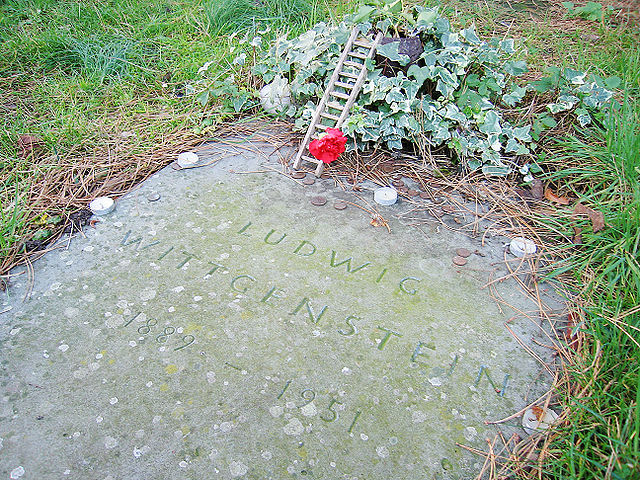 |
This is a file from the Wikimedia Commons. Information from its description page there is shown below.
Commons is a freely licensed media file repository. You can help.
|
Ludwig Wittgenstein's gravestone in the graveyard of the chapel for Ascension Parish Burial Ground off Huntingdon Road, Cambridge, UK. The graveyard was previously known as St. Giles Cemetery in association with the parish of St. Giles church at the bottom of Castle Hill.
The graveyard is the last resting place of a number of fellows from Cambridge colleges. In addition to Wittgenstein, the grave of the philosopher G. E. Moore is here, as are the graves of two of Charles Darwin's sons. Being a little out of the city, it has the reputation of being a cemetery for non-conformists or non-Christians. Tucked away in the corners are graves for Indian, Arabic and Jewish scholars who happen to have died whilst still in Cambridge.
Although still in use, the graveyard is predominantly late Victorian with many an ornamental headstone; there are more than a few ornately carved Celtic knot crosses. In contrast, Wittgenstein's grave is marked with a simple slab of stone laid flat on the ground. The only inscription reads,
LUDWIG WITTGENSTEIN
1889 - 1951
"That's all he wanted, plain like that," the caretaker told Robert Angelo in 1980 .
The grave is usually lightly covered with large pine needles from the overlooking trees. It has a small but steady stream of visitors, as implied by the fresh carnation somebody has left. I don't know the significance of the miniature ladder, but it has been there for a few years. It is probably part of a recent trend to leave small items at the grave, as are the scattering of pennies and the votive candles.
- Curiouser and curiouser - A letter to the editor from Nick Ingham in The Times, 3rd September, 2001, page 15. "Today there were 18 1p coins on the grave of Ludwig Wittgenstein at the Parish of the Ascension Burial Ground in Cambridge. Originally - some days ago - there were four, spread about; and then five in a little pile to one side. This morning there were 15 neatly underlining his name. Now there are three more, still neatly lined up. Over the years numerous small objects have been placed on the grave including a lemon, a pork pie, a Mr Kipling cupcake and a Buddhist prayer wheel. It is all very intriguing."
The Ladder
Wittgenstein famously wrote in section 6.54 of his book Tractatus Logico-Philosophicus:
-
- "My propositions are elucidatory in this way: he who understands me finally recognizes them as senseless, when he has climbed out through them, on them, over them. (He must so to speak throw away the ladder, after he has climbed up on it.) He must surmount these propositions; then he sees the world rightly."
| Photograph © Andrew Dunn, 19 December 2004. |
| Website: http://www.andrewdunnphoto.com/ |
|
I, the copyright holder of this work, hereby publish it under the following license:
|
|
|
File usage
The following pages on Schools Wikipedia link to this image (list may be incomplete):
Schools Wikipedia was created by children's charity SOS Childrens Villages. SOS Children's Villages believes education is an important part of a child's life. That's why we ensure they receive nursery care as well as high-quality primary and secondary education. When they leave school, we support the children in our care as they progress to vocational training or higher education. Would you like to sponsor a child?


